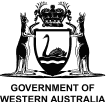Westport has partnered with the Western Australian Marine Science Institution (WAMSI) to deliver the $13.5 million WAMSI-Westport Marine Science Program. This 3-year program is developing the latest data, information and modelling on the complex environmental systems and community values associated with Cockburn Sound.
Project 4.2.1: Spatial distribution and temporal variability in life stages of key fish species in Cockburn Sound
Research theme: Fisheries and Aquatic Resources
Researchers: D. Yeoh, P. Mitchell, J. Tweedley, D. Johnston, D. Fairclough, L. West, K. Krispyn, J. Seymour, B. Scoulding, J. Nilsen, S. Fourie, J. Norris, J. McIlwain, P Middelfart, G. Jackson.
Publication date: June 2025
Understanding the distribution and abundance of larvae, juvenile and adult fish and invertebrate key species in Cockburn Sound
Understanding the importance of Cockburn Sound as a hatchery for key fish and invertebrates and how they connect with stock in nearby waters, is critical to developing mitigation strategies to protect these species during the development of the port.
This research project, which included wide consultation with scientific experts and industry, identified a suite of fish and invertebrate species/families that are most important to Cockburn Sound and/or potentially at risk from development.
The project mapped the key habitat types for 24 taxa, the environmental factors that impact their distribution and development, and investigated methods for long‐term monitoring of the abundance of adult snapper in spawning aggregations.
A two-year comprehensive sampling program was undertaken, and included a broad range of survey methods like trawls, seines, bongo nets, light traps, BRUV, acoustics, drones, crab traps and squid jigging, from waters around Perth down to Rockingham.
This project has substantially increased knowledge of Cockburn Sounds’ biodiversity and resulted in one of the most comprehensive fish and invertebrate datasets available for any marine area in WA.
What the study found
- More than 582,000 individual fishes and invertebrates were recorded, including 251 taxa from 77 families of teleosts, 84 of which are important fisheries to WA.
- In the Kwinana region there was a high abundance of blue swimmer crab, southern calamari, scaly mackerel, sandy sprat, blue sprat, Australian herring and whiting schools.
- Acoustic and drone surveys also confirmed that snapper spawning aggregations occur in this region during spring.
- Marked inter‐annual differences were shown between years (2021/22 vs. 2022/23) for many species such as sandy sprat, highlighting the natural variability in populations and importance of multi‐year sampling for assessments and monitoring.
How Westport will use the report
Westport will use this research to inform its environmental management program, including mitigating impacts to key fish and invertebrates in Cockburn Sound during the development of the port.
You can read the full report here.





